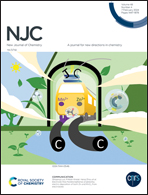Porous MnO nanoplate–graphene hybrid as a high-capacity anode material for lithium ion batteries and its safety characteristics†
Abstract
To tackle the issue of inferior rate capability and cycle stability for MnO-based materials as a lithium-ion battery (LIB) anode, robust reduced graphene oxide (rGO) protected porous MnO nanoplates were constructed to relieve the pulverization and gradual aggregation during the conversion process. Such rGO protection and porous characteristics endowed MnO–rGO with excellent cycle stability and enhanced charge transfer kinetics. At 100 mA g−1, it exhibited superior rate capability as high as 1398.5 mA h g−1 and delivered a specific capacity of 726 mA h g−1 even at a current density of 1000 mA g−1. The porous MnO–rGO based cell exhibited thermal runaway at 204 °C, while the commercial graphite-based cell experienced thermal runaway at 197 °C, which demonstrated better safety performance. This facile method provides an efficient and low-cost approach to synthesizing rGO wrapped porous transition metal oxides electrodes for LIB applications.



 Please wait while we load your content...
Please wait while we load your content...